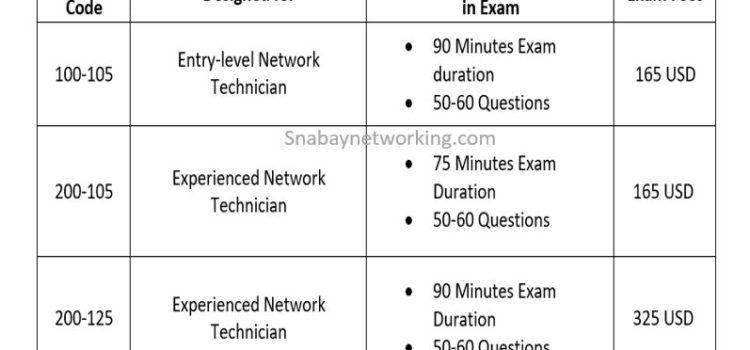CCNA Syllabus Exam Fees Duration
CCNA R & S is short for Cisco Certified Network Associate Routing and Switching. It is the popular certification among all the network engineers. The CCNA was developed by the Cisco to test the knowledge of the Candidate of networking at the Entry level. It is a certification program that is valid for all type of engineers like entry-level network engineers, Network support engineers, Network Administrators, and Network Specialists. To know more about the “CCNA Syllabus Exam Fees Duration” keep reading this article till the end.
The Cisco Certified Network Associate (Routing and Switching) is recognized by IT employers when considering a fresher’s profile for a vacancy or for an increment in salary and the promotion for the experienced employees.
The CCNA certificate covers a broad range of networking concepts. It helps candidates to prepare for the latest network technologies they are likely to work on.
Note: Cisco Certification is valid only for 3 years. Once the certification expired of the certificate holder has to take CCNA certification again.
Why to acquire CCNA Certification
Cisco like Microsoft and other vendors that provide certification has created the certification process to give administrators a set of skills and to equip prospective employers with a way to measure those skills or match certain criteria.
The CCNA program was created to provide a solid introduction not only to the Cisco internetwork operating system and Cisco hardware but also to internetworking in general, making it helpful to you in areas that are not exclusively cisco’s.
What skills are required for a CCNA R&S
The ICND1 exam (100-105) tests a candidate for the knowledge and skills required. These are:
- They able to install, operate and troubleshoot a small branch office network.
- Candidates have the knowledge of the operation of IP data networks,
- They also have the knowledge of LAN Switching technologies, IPv4 and IPv6, Ip Routing Technologies, Ip services, network device security, and basic troubleshooting.
- The ICND1 exam includes questions on LAN switching technologies, Ip routing technologies, security, troubleshooting, and Wide Area Network Technologies. One can look for some of the free IT exams questions, to prepare for the said exam.
- It provides the ability to the candidate to create a point to point network
- It also provides the ability to meet user requirements by determining and analyzing the network topology.
This Certification provides the professional’s ability to configure, operate, troubleshoot and understand small and medium-level switched and routed network. It also includes the verification and implementation of connections via remote sites using WAN Technologies.
Types of Cisco Certified Network Associate (CCNA) Exam.
To secure CCNA. Basically, there are two approaches. These are:
- ICND1 Exam and ICND2
- CCNA Exam (Combined)
What Does the Syllabus of CCNA consist of:
CCNA Consists of ICND1 and ICND2. The Syllabus of CCNA is the Combined syllabus of ICND1 and ICND2 :
Syllabus of ICND1:
Internetworking
- Internetworking Basics
- The OSI Reference Model
Ethernet Networking and Data Encapsulation
- Collision Domain
- Broadcast Domain
- CSMA/CD
Ethernet Cabling
- Straight through Cable
- Crossover Cable
- Rolled over Cable
- Fiber optics
Data Encapsulation
- The Core layer
- The Distribution Layer
- The Access Layer
Introduction to TCP/IP
- TCP/IP and the DOD Model
- IP Addressing
- IPv4 Address Types
Easy Subnetting
- How to create subnets
- Subnet Mask
- Classless Inter-Domain Routing
- IP subnet-zero
- Subnetting of Class A, B, and C.
VLSM, Summarization, and Troubleshooting TCP/IP
- Variable Length Subnet Mask (VLSMs)
- Summarization
- Troubleshooting IP Addressing
Cisco Internetworking Operating System (IOS)
- The IOS User Interface
- Command Line Interface (CLI)
- Administrative Configurations
- Router and Switch Interface
Managing a Cisco Internetwork
- The internal Components of Cisco Router and switch
- Backing up and restoring the Cisco Configuration
- Configuring DHCP
- Syslog
- Using Telnet
- Resolving Hostnames
- Checking network Connectivity and Troubleshooting
Managing Cisco Devices
- Managing the Configuration register
- Backing up and Restoring the Cisco IOS
Ip Routing
- Routing Basics
- IP Routing Process
- Configuring IP routing
- Static and Default Routing
- Dynamic Routing
- Routing Information Protocol
Layer2 Switching
- Switching Services
- Configuring Catalyst switches
VLAN and Inter-VLAN Routing
- VLAN Basics
- Identifying VLANs
- Routing between VLANs
- Configuring VLANs
Security
- Introduction to Access Lists
- Standard Access Lists
- Extended Access Lists
Network Address Translation
- Types Network Address Translation
- How NAT works
- Testing and troubleshooting NATs
Internet Protocol Version 6
- Benefits and Uses of IPv6
- Working of IPv6 in Internetworking
- IPv6 Routing Protocols
- Configuration of IPv6
Syllabus of ICND2
Enhanced Switched Technologies
- Vlans review
- VTP and its Configurations
- Spanning Tree Protocols (STP)
- Types of Spanning Tree protocols
- Ether-Channel
Network Device Management and Security
- Mitigating Threats at the Access Layer
- Simple Network Management Protocol
- HSRP and FHRPs
Enhanced IGRP
- EIGRP Features and Operations
- Configuration EIGRP
- Verifying and Troubleshooting Eigrp
Open Shortest Path First (OSPF)
- OSPF Basics
- Configuring OSPF
- OSPF and Loopback Interface
- Verifying OSPF Configuration
Multi-Area OSPF
- OSPF Scalability
- Categories of Multi-Area Components
- Basic Multi-area Configuration
- OSPFv3
Troubleshooting IP, IPv6, and Vlans
- Troubleshooting IP Network Connectivity
- Troubleshooting IPv6 Extended Access lists
Wide Area Network
- Cabling the serial wide area network
- High-Level Data Link Control Protocol (HDLC)
- Point to Point Protocol
- Virtual Private Network Protocol
- GRE Tunnels
- Single-Homed EBGP
Evolution of Intelligent Networks
- Switch Stacking
- Cloud Computing and its Effect on the Enterprise network
- Application programming interface
- Cisco APIC- EM
- Cisco Intelligent WAN
- Quality of Service
Also read…


Leave a comment